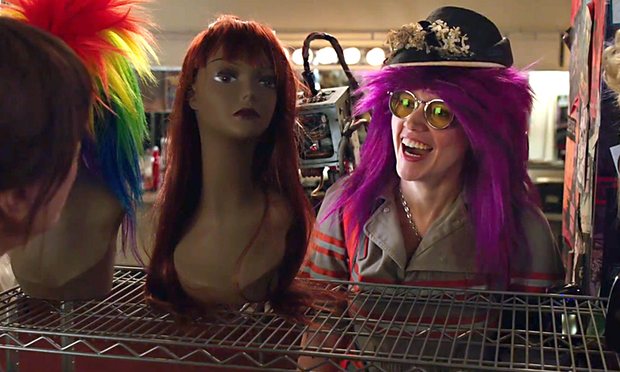
Ghostbusters was a preternatural hit back in 1984. It raked in $242 million dollars in gross domestic box office, established Bill Murray as a bonafide movie star, and was—for people of a certain age (cough, cough)—a legitimate cultural touchstone.
Released more than 30 years later, the remake—or reboot, if you prefer, considering there are likely to be plenty of sequels to come—does not rise to that level, but it is still fast-paced, consistently funny, high-quality summer entertainment.
The year is 2016, and New York City is grappling with an unusual spike in supernatural activity. Estranged academic collaborators Abby and Erin (Melissa McCarthy and Kristen Wiig) find themselves reunited by circumstance to investigate a local haunting, and they come face-to-face (and then some) with a malevolent apparition that more or less proves their metaphysical theories. When the video of their apparently-phantasmagoric encounter hits YouTube, both are fired from their academic posts—Erin from Ivy League Columbia University and Abby from a low-rent NYC technical college—leaving them little choice but to go into business for themselves as private paranormal investigators. Abby brings her assistant Jillian (Kate McKinnon) along with them, and eventually they add a fourth ghostbuster, Patty (Leslie Jones), and an oblivious-but-hunky secretary, Kevin (Chris Hemsworth), to their team. There is a modicum of political intrigue along the way and a forgettable human villain to be reckoned with, but mostly these gals spend the rest of this movie battling rampaging spirits from the great beyond.
Lest we forget the embarrassing, (let’s-just-call-it-what-it-is) misogynistic uproar over casting this film with four women instead of four men, Ghostbusters has been mired in hate-spewing social media controversy for the better part of the last year. A certain segment of the movie-going public found itself positively aghast that Ghostbusters 2016 would continue to prosecute the proverbial “war on men” that began when The Force Awakens planted a female character at the center of a galaxy far, far away. Angry trolls everywhere lashed out from their parents’ basements and filled online comment sections and social media timelines with vitriolic screeds of hate and disappointment, demanding that the filmmakers give them an XY reboot instead of the soft, fuzzy XX version that they were sure they’d get.
The irony of that, of course, is that in today’s Hollywood there is no comedian–male or female–with more box office clout than Melissa McCarthy, so why wouldn’t she headline a high-profile summer comedy? Add in Kristen Wiig—who single-handedly kept Saturday Night Live afloat for several seasons in the 2000’s and also headlined a little $170 million hit comedy called Bridesmaids—and you’ve got some serious juice behind this movie.
What’s interesting here, though, is that while McCarthy and Wiig anchor Ghostbusters admirably and do most of the heavy lifting in terms of plot development and emotional stakes, it is Kate McKinnon who delivers not only the lion’s share of the laughs but also the one true breakout performance of the film.
In a movie inspired by (kind of sort of) the Book of Revelation, McKinnon is a revelation unto herself.
Anyone who has watched Kate McKinnon on SNL over the past few years knows the raw comedic talent that she brings to the party. From her much-heralded take on Hillary Clinton to her smarmy imitation of Justin Bieber to her white trash alien abductee that forced character-breaking fits of laughter out of her fellow performers (hands-down the best sketch of SNL’s recent season), McKinnon has got the goods in spades.

In Ghostbusters, McKinnon gets to spread her wings and experiment with a weird, probing performance that sets her apart from her costars in a way that really elevates the comedy. While McCarthy and Wiig get their laughs through more restrained performances and while Jones stays pretty much in the same box she has constructed for herself since coming onto the national scene, McKinnon gets to freestyle here, and the results are sublime. Like the background musician who suddenly overshadows the lead singer and brings the house down with an improvised guitar solo, McKinnon goes big and goes weird, making such interesting and unconventional choices with her character that you just can’t wait to see what she’s going to do next. More often than not, she gets it right and delivers.
Apart from McKinnon, one of the most notable things about this new Ghostbusters is its complete self-awareness and affection for its predecessor.
A parade of cameos throughout the film serve less as moments of comic inspiration than they do as endorsements from or tributes to the original Ghostbusters’ cast. Despite a flashy appearance by Bill Murray, the most affecting of these is a don’t-blink-or-you’ll-miss-it homage to Harold Ramis—co-writer and co-star of the original—who passed away in 2014 but appears here as a bronze bust outside Erin’s office at Columbia. Casual fans will recognize and appreciate the appearances by Murray, Dan Aykroyd, Sigourney Weaver, the Stay Puff Marshmallow Man, and others; but only the true fan will choke up over that brief glimpse of Ramis’ unmistakable figure standing guard in the hallway. His is the one ghost we hope our squadron of wonderful women warriors don’t blast back into the other dimension.
